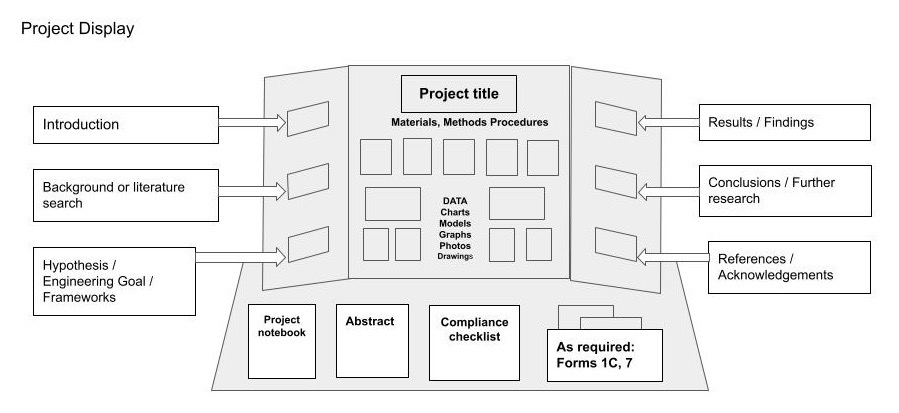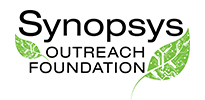
Required for all projects: Project Abstract; Compliance Checklist; Project Notebook (optional for middle school); Form 1C for RRI projects; Form 7 for continuation projects;
Required but NOT displayed: Print and bring Approval Form 1B, 4, 6A, 6B and signed Ethics Statement (Do not bring Form 1, 1A, 2, 3, 5A, 5B or Research Plan.
*DO NOT include School name
*DO credit all images
*Display should include only your work and only work done this year
EXHIBIT SIZE
- Not to exceed 15 inches (38 cm) deep, front to back; 48 inches (122 cm) wide, side to side; and 5 ft (150 cm) high above the table top. Examples of project boards here.
- Display materials must fit on the table in front of your board. This space is approx. 15″ x 24″.
- Display boards of 3-4 ft height (vs 5 ft) are recommended for readability by the judges.
TEXT
- Use size 24-point or larger font.
- Position your main points at eye level.
NAMES
- Student name(s) may appear on the display board; and they will be printed on the poster location label.
REFERENCES
- References (Bibliography) are required on the display board.
- If the bibliography is very long, include “Selected References” on the board and have an available copy of the complete list.
ACKNOWLEDGEMENTS
Only minimal reference to a mentor’s or another researcher’s work is allowable. Naming the institution is not allowable.
ABSTRACT & NOTEBOOK
- Display your abstract and original notebook (kept during your work) with your project.
- Bring one copy of your abstract to tape to the table at your display.
FORMS
- Compliance Checklist and Forms 1C and 7 if your project requires them.
- DO NOT display but have printed copies of Forms 1, 1A, 1B, 2, 3, 4, 5A, 5B, 6A, 6B, signed Ethics Statement and Research Plan.
- DO NOT bring Human Informed Consent Forms on Judging Day.
NOT ALLOWED AS PART OF THE DISPLAY
- ❌ Research Institution logos
- ❌ School names or logos
- ❌ Formal Project Summaries for distribution
- ❌ PowerPoint® presentations or digital equivalents on a laptop (other than demos or videos of data that cannot be displayed in any other way)
- ❌ Any reference to an institution or mentor that supported the finalists research except as provided in an acknowledgment section of the poster and within official ISEF paperwork, most notably Form 1C
- ❌ Any reference to patent status of the project
- ❌ Any items intended for distribution such as disks, CDs, flash drives, brochures, booklets, endorsements, give-away items, business cards, printed materials or food items designed to be distributed to judges or the public
- ❌ Awards, medals or acknowledgements from previous fairs.
- ❌ Postal addresses, World Wide Web, email and/or social media addresses, QR codes, telephone and/or fax numbers of a project or finalist. Note: The only personal information that is permissible to include on the display is information that is also included on the Abstract Information regarding finalist’s age, grade, school or teacher name are not permitted.
- ❌ Photographs of people other than student presenter(s) unless signed Form 4 is available.
- ❌ Photographs or other visual presentations depicting vertebrate animals in surgical techniques, dissections, necropsies, other lab techniques, improper handling methods, improper housing conditions, procedures, etc.
Use photos or drawings instead of these disallowed physical objects:
- ❌ All liquids and laboratory or household chemicals, including water. Absolutely no liquids can be utilized in the Project Display.
- ❌ Human or animal food (e.g., popcorn, M&Ms, etc.)
- ❌ Living organisms (including plants, fungi, and bacteria)
- ❌ Glass
- ❌ Soil, sand, rock, cement and/or waste samples, toxic waste samples
- ❌ Plant materials (living, dead, or preserved) that are in their raw, unprocessed, or non-manufactured state
- ❌ Taxidermy specimens or parts
- ❌ Preserved vertebrate or invertebrate animals or their parts
- ❌ Human/animal parts or body fluids (blood, urine)
- ❌ Batteries with open-top cells or wet cells
- ❌ Poisons, drugs, controlled substances, hazardous substances or devices (for example: firearms, weapons, ammunition, reloading devices, grease/oil, model rockets)
- ❌ Dry ice or other sublimating solids (solids which vaporize to a gas without passing through a liquid phase)
- ❌ Sharp items (for example: syringes, needles, pipettes, knives)
- ❌ Any flames, open or concealed, or highly flammable materials
- ❌ Gases or empty tanks that previously contained combustible liquids or gases, including butane and propane
- ❌ Drones or any flight-capable apparatus unless the propulsion power source is removed
- ❌ 3D printers unless the power source is removed
- ❌ Any display items that are deemed distracting (i.e. sounds, lights, odors, etc.)
PROTOTYPES & SOFTWARE DEMONSTRATIONS
- Hardware prototypes may be brought into the hall for judging; however, display space is limited and display of your prototype is not required. Instead, provide photos and data for the judges.
- Hardware prototypes entering the hall must meet size and safety requirements.
- Software should be available for demo on a device such as a phone, tablet or laptop.
- If your device requires an internet connection, provide your own hotspot if possible.
- Provide data which verifies and validates the software results.
DISPLAY SAFETY/ELECTRICAL REGULATIONS
Proper attention to safety is expected of all participants, including compliance with the following requirements:
- No operation of unshielded belts, pulleys, chains, or moving parts with tension or pinch points.
- Inadequately insulated apparatus capable of producing dangerous temperatures are NOT permitted.
- Properly fasten all wiring. Nails, tacks, or unshielded staples are not acceptable.
- Electrical power: Only supplied to projects which cannot be displayed any other way. NOT FOR LAPTOPS alone.
- Electrical power supplied to approved projects and, therefore, the maximums allowed for projects is 120 or 220 Volt, A.C., single phase, 60 cycles. Maximum circuit amperage/wattage available is determined by the electrical circuit capacities of the exhibit hall and may be adjusted on-site by the Display and Safety Committee. For all electrical regulations “120 Volt A.C.” or “220 Volt A.C.” is intended to encompass the corresponding range of voltage as supplied by the San Jose Convention Center.
- All electrical connectors, wiring, switches, extension cords, fuses, etc. must be UL-listed and must be appropriate for the load and equipment. Connections must be soldered or made with UL-listed connectors. Wiring, switches, and metal parts must have adequate insulation and over-current safety devices (such as fuses) and must be inaccessible to anyone other than the Championship participant. Exposed electrical equipment or metal that may possibly be energized must be shielded with a non-conducting material or with a grounded metal box to prevent accidental contact.
- Wiring that is not a part of a commercially available UL-listed appliance or piece of equipment must have a clearly visible fuse or circuit breaker on the supply side of the power source and prior to any project equipment.
- Decorative lighting or illumination is discouraged. If used, lighting must be as low a voltage as possible and must be LED lighting that does not generate heat. Incandescent and fluorescent light bulbs are prohibited. When student is not at the exhibit, all electrical power must be disconnected, or power bars must be switched off (Exception; during pre judging audio visual displays may be available).
- An insulating grommet is required at the point where any wire or cable enters any enclosure.
- No exposed live circuits over 36 volts are allowed.
- There must be an accessible, clearly visible on/off switch or other means of disconnect from the 120 or 220 Volt power source.
- Digital demos or videos can be made from battery powered laptops only, and are allowed only to provide data unavailable in any other format. At its discretion, the compliance committee may restrict the operation of the project, or exhibition of specified items, to the time of judging only. Failure to follow these restrictions can result in project disqualification after judging is completed.
Laser Pointer Regulations
Any Class, 1, Class 2, Class 3A, or Class 3R lasers are allowed to be used responsibly. No other lasers, like the Class III or Class IV, may be used or displayed.
- Laser beams may not pass through magnifying optics such as microscopes and telescopes.
- Lasers must be labeled by the manufacturer so that power output can be inspected, Lasers without labels will NOT be permitted.
- Handheld lasers are NOT permitted.
- Lasers will be confiscated with no warning if not used in a safe manner.
The Santa Clara Valley Science and Engineering Fair Association will disqualify any exhibit which, in its opinion, does not comply with all preceding Project Display Rules.
Loss or Damage
The Santa ClaraValley Science and Engineering Fair Association assumes no responsibility for loss or damage to any project or project part. Valuable items should be simulated or removed when the student is not present at his/her project.
Projects not removed by 6:30 PM on Fair Day may be destroyed.

